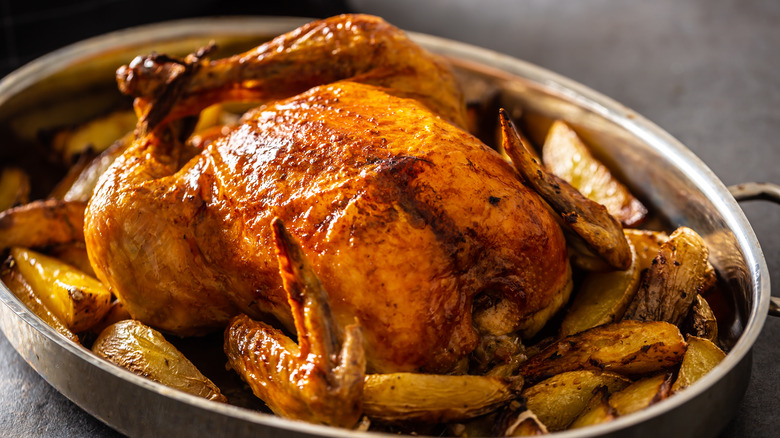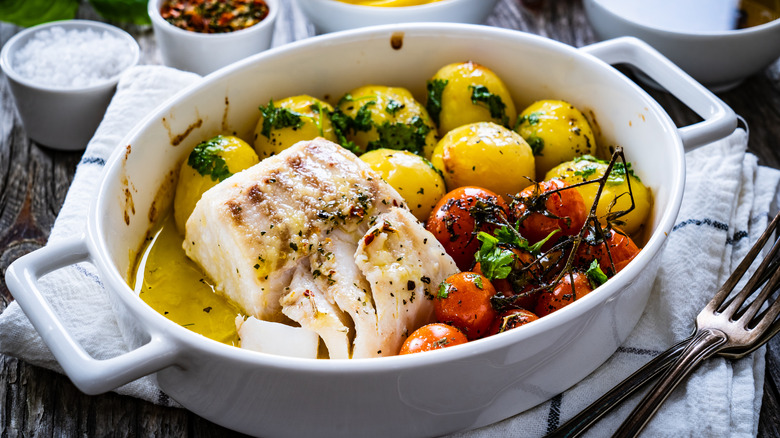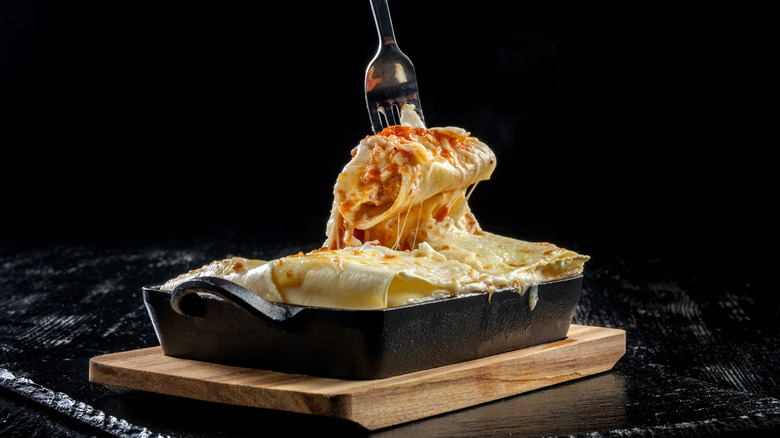What You Should Consider Before Purchasing A Roasting Pan
While that picture-perfect turkey always wins the prestigious best actor award as the star of our holiday dinners, the roasting pan rightfully deserves its own Oscar for the best supporting role. The New York Times insists that, no matter what your level of expertise is, the right culinary tools will help make the outcome that much better.
Although often associated with Thanksgiving dinner, the right roasting pan can be a go-to method for many different occasions — it's the ideal choice for a variety of crowd-pleasing dishes like roasted veggies, enchiladas, lasagna, or even a large casserole. This is a tool that can truly broaden the horizons of a home cook, and one that almost no one regrets adding to their arsenal. So what should you consider when shopping for the perfect pan? We've rounded up some suggestions and things to keep in mind to help you avoid the mistakes everyone makes when roasting your next meal and turn it into a showstopper instead.
The essentials: size, color, material
Cooking with a roasting pan can provide a few key advantages compared to traditional baking sheets. Due to its large size and material, it can absorb and distribute heat more effectively to give your meat or veggies the even, flavorful cooking they deserve (via Caraway). In addition to handling the heat from the oven, it is recommended that the roaster be safe to use in the broiler and on the stovetop as well, according to Taste of Home – and as an extra bonus to the clean-up crew, a good roasting pan is dishwasher friendly.
Watch out for dark-colored pans, warns Taste of Home, because this can add a darker crust to the outside of food and possibly burn it. Senior food editor Marguerite Preston shares with The New York Times that "it's better to use light-colored bare aluminum for the same reason it's better to wear a white T-shirt than a black one on a hot day: dark colors absorb heat, light colors reflect it." Ceramic and glass pans heat slowly, making them a perfect option for casseroles, while cast iron vessels are best for cooking at high temperatures and can safely move to the broiler or stovetop.
As a helpful rule of thumb, Yuppie Chef suggests having 5- to 8-centimeter tall edges for proper air circulation as well as to improve the ability to keep liquid in the pan. A pan that is too shallow can lead to spill issues while too deep of a vessel can turn an attempted roast into a steam show (via Caraway).
Powerlifting: for the gym, not the kitchen
Of course, the most important thing is that you can carry it! You won't be able to impress anyone with your dish if you drop the entire meal on your kitchen floor, and you certainly don't want Grandma to injure herself when taking it out of the oven. As long as it doesn't break your back, a heftier pan will allow for a more even heat distribution — which is important for both roasting and sauce making, according to Fine Cooking. So make sure any roasting pan you buy comes with handles that are easy to grip and sturdy.
Lastly, there is an age-old debate over whether you should use non-stick pans or not. While a non-stick pan is always tempting, it may not be safe for broiler use (via Taste of Home). And while non-stick is easier to clean, health experts warn that the surface may contain chemicals that make the surface toxic — and scratched nonstick pans might not be safe to use. The best course of action is to investigate what a pan is made out of and how it will affect your cooking before purchasing.
Now that you are armed with some tips and suggestions, you'll be able to find that perfect pan to take your cooking to the next level!


